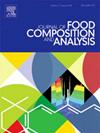摘要
本研究采用固相萃取-气相色谱-三重四极杆质谱法分析腌菜中的多环芳烃和超高芳烃。在市售的雪菜中,PAH24(包括 EPA PAH 16 和 EU PAH15+1)的浓度为 43.0±3.9 μg/kg,XPAH18(包括 11 种氯化 PAH 和 7 种溴化 PAH)的浓度为 0.52±0.07 μg/kg;在实验室腌制的萝卜中,PAH24 的浓度为 28.3±8.7 μg/kg,XPAH18 的浓度为 0.25±0.11 μg/kg。在整个腌制过程中,多环芳烃的浓度普遍下降,而徐才厚中的 XPAHs 和萝卜中的氯化多环芳烃(ClPAHs)则先上升后下降。与未发酵的萝卜相比,发酵萝卜中的 ClPAH 含量升高,加上秀才中新形成的 1-氯化芘,突出表明在腌制过程中产生了 ClPAHs。在盐度较低的情况下,多环芳烃浓度的降低幅度较大,而 ClPAHs 的增加幅度最大,这表明一些多环芳烃可能通过微生物活动氯化成 ClPAHs。虽然腌制后 ClPAHs 的浓度上升,但发酵后腌菜中 PAH42(包括 PAH24 和 XPAH18)的毒性当量商均低于未发酵和发酵样本,这表明成熟腌菜不会增加 PAHs 和 XPAHs 的总体毒性风险。In this study, solid-phase extraction coupled with gas chromatography–triple quadrupole mass spectrometry was used for analyzing PAHs and XPAHs in pickles. The concentrations were 43.0±3.9 μg/kg for PAH24 (including EPA PAH 16 and EU PAH15+1) and 0.52±0.07 μg/kg for XPAH18 (including 11 chlorinated PAHs and 7 brominated PAHs) in commercially available xuecai, and 28.3±8.7 μg/kg for PAH24 and 0.25±0.11 μg/kg for XPAH18 in laboratory-pickled radish. Throughout the pickling process, concentrations of PAHs generally decreased, while XPAHs in xuecai and chlorinated PAHs (ClPAHs) in radish initially increased before declining. The elevated ClPAH levels in fermented radish compared to their unfermented counterparts, along with the newly formed 1-chlorinated pyrene in xuecai, highlighted the generation of ClPAHs during pickling. At lower salinity levels, the greater reduction in concentrations of PAHs corresponds with the largest increase in ClPAHs, suggesting potential chlorination of some PAHs into ClPAHs via microbial activity. Although concentrations of ClPAHs rose after pickling, the toxic equivalent quotients of PAH42 (including PAH24 and XPAH18) in pickles after fermentation were lower than those in both unfermented and fermenting samples, indicating that mature pickles did not increase the overall toxicity risk associated with PAHs and XPAHs.

 求助内容:
求助内容: 应助结果提醒方式:
应助结果提醒方式:


